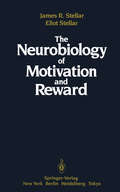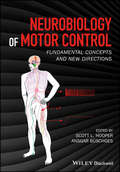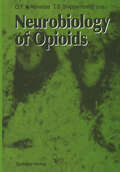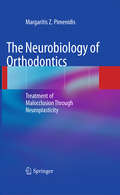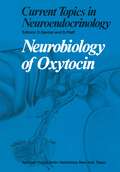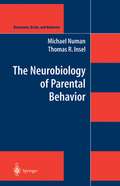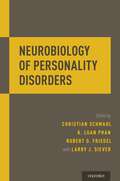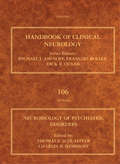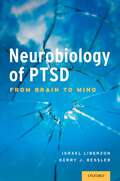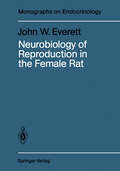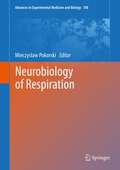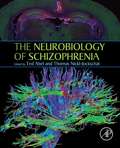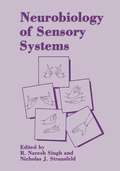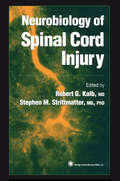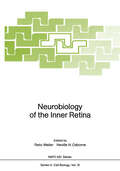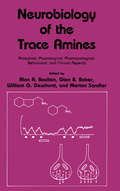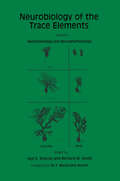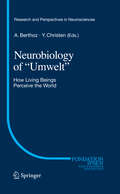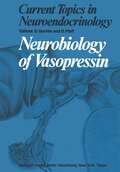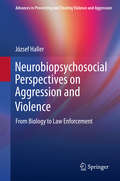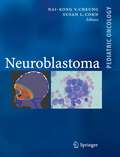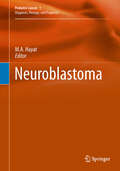- Table View
- List View
The Neurobiology of Motivation and Reward
by James StellarThis book was conceived many years ago as an abstract goal for a father-son team when the father was working in university administration and the son was just getting into the academic business. Eventually, the father returned to the laboratory, the son began to get his feet on the ground, and the goal became concrete. Now the work is finished, and our book enters the literature as, we hope, a valuable contribution to understanding the terribly complex and subtle problem of the neuro biology of motivated behaviors. We would also like the book to stand as a personal mark of a cooperative relationship between father and son. This special relationship between the authors gave us an extra dimension of pleasure in writing the book, and it would delight us if it gave anyone else an extra dimension of enjoyment from reading it. One thing we hope happens is that anyone or simply considering entering similar considering a similar partnership, of this book as encouragement. Such re fields, will take the existence lationships are highly satisfying if both parties take care to protect the partnership. When we actually sat down to write the book, we were humbled by the immense literature and the smallness of both our conceived space for putting it down and of our brains for processing all the information.
Neurobiology of Motor Control: Fundamental Concepts and New Directions
by Scott Hooper Ansgar BüschgesA multi-disciplinary look at the current state of knowledge regarding motor control and movement—from molecular biology to robotics The last two decades have seen a dramatic increase in the number of sophisticated tools and methodologies for exploring motor control and movement. Multi-unit recordings, molecular neurogenetics, computer simulation, and new scientific approaches for studying how muscles and body anatomy transform motor neuron activity into movement have helped revolutionize the field. Neurobiology of Motor Control brings together contributions from an interdisciplinary group of experts to provide a review of the current state of knowledge about the initiation and execution of movement, as well as the latest methods and tools for investigating them. The book ranges from the findings of basic scientists studying model organisms such as mollusks and Drosophila, to biomedical researchers investigating vertebrate motor production to neuroengineers working to develop robotic and smart prostheses technologies. Following foundational chapters on current molecular biological techniques, neuronal ensemble recording, and computer simulation, it explores a broad range of related topics, including the evolution of motor systems, directed targeted movements, plasticity and learning, and robotics. Explores motor control and movement in a wide variety of organisms, from simple invertebrates to human beings Offers concise summaries of motor control systems across a variety of animals and movement types Explores an array of tools and methodologies, including electrophysiological techniques, neurogenic and molecular techniques, large ensemble recordings, and computational methods Considers unresolved questions and how current scientific advances may be used to solve them going forward Written specifically to encourage interdisciplinary understanding and collaboration, and offering the most wide-ranging, timely, and comprehensive look at the science of motor control and movement currently available, Neurobiology of Motor Control is a must-read for all who study movement production and the neurobiological basis of movement—from molecular biologists to roboticists.
Neurobiology of Motor Control: Fundamental Concepts and New Directions
by Scott L. Hooper Ansgar BüschgesA multi-disciplinary look at the current state of knowledge regarding motor control and movement—from molecular biology to robotics The last two decades have seen a dramatic increase in the number of sophisticated tools and methodologies for exploring motor control and movement. Multi-unit recordings, molecular neurogenetics, computer simulation, and new scientific approaches for studying how muscles and body anatomy transform motor neuron activity into movement have helped revolutionize the field. Neurobiology of Motor Control brings together contributions from an interdisciplinary group of experts to provide a review of the current state of knowledge about the initiation and execution of movement, as well as the latest methods and tools for investigating them. The book ranges from the findings of basic scientists studying model organisms such as mollusks and Drosophila, to biomedical researchers investigating vertebrate motor production to neuroengineers working to develop robotic and smart prostheses technologies. Following foundational chapters on current molecular biological techniques, neuronal ensemble recording, and computer simulation, it explores a broad range of related topics, including the evolution of motor systems, directed targeted movements, plasticity and learning, and robotics. Explores motor control and movement in a wide variety of organisms, from simple invertebrates to human beings Offers concise summaries of motor control systems across a variety of animals and movement types Explores an array of tools and methodologies, including electrophysiological techniques, neurogenic and molecular techniques, large ensemble recordings, and computational methods Considers unresolved questions and how current scientific advances may be used to solve them going forward Written specifically to encourage interdisciplinary understanding and collaboration, and offering the most wide-ranging, timely, and comprehensive look at the science of motor control and movement currently available, Neurobiology of Motor Control is a must-read for all who study movement production and the neurobiological basis of movement—from molecular biologists to roboticists.
Neurobiology of Opioids
by Osborne F. X. Almeida A. Goldstein Toni S. ShippenbergDedicated to Professor Albert Herz, a leading investigator in opioid research, this book provides comprehensive information on the biology of exogenous and endogenous opioids. Contributions by experts in the field discuss recent advances and provide systematic, up-to-date reviews of the physiology and pharmacology of opioids, as well as on the cellular and molecular mechanisms underlying opioid actions. In recognition of the diverse methodologies now available to researchers, each chapter details the approaches used to address a specific issue and provides an in-depth analysis of the data obtained by these various experimental approaches. The clinical relevance of recent findings, as well as future directions, in opioid research are also discussed. This volume thus represents a timely and invaluable sourcebook for researchers, clinicians, and students interested in opioids and peptidergic systems.
The Neurobiology of Orthodontics: Treatment of Malocclusion Through Neuroplasticity
by Margaritis Z. PimenidisThis book presents the neurobiology of orthodontics according to the most recently acquired knowledge on the interaction of the brain activity with the senses. In particular, it highlights the ability of orofacial sensory input to modulate and change the brain activity underlying functions of the stomatognathic system, such as chewing, biting, speech, and occlusal feedback. The approach adopted thereby represents a significant departure from traditional orthodontics, in which malocclusions of the teeth have been interpreted as deriving from DNA coding errors. The described new conceptualization of the etiology and diagnosis of malocclusions has profound implications for orthodontic therapy, as is clearly explained. Orthodontic therapy in turn has significant effects on the brain, which are documented in a chapter devoted to neuroimaging methods. By opening up new and creative pathways in the world of orthodontics, this book will hopefully both educate and excite the practitioner. It is recommended reading for all orthodontists.
Neurobiology of Oxytocin (Current Topics in Neuroendocrinology #6)
by J.P.H. Burbach M. L. Forsling R. Ivell G. L. Kovacs B. T. Pickering D. G. Porter I.C.A.F. Robinson R. W. Swann D. C. WathesThe Neurobiology of Parental Behavior (Hormones, Brain, and Behavior #1)
by Michael Numan Thomas R. InselIn addition to filling a need within the field of parental behavior, this book contributes importantly to the growing area of emotional and motivational neuroscience. A major part of neuroscience research at the whole organism level has been focused on cognitive neuroscience, with an emphasis on the neurobiology of learning and memory, but there has been a recent upsurge in research which is attempting to define the neural basis of basic motivational and emotional systems which regulate such behaviors as food intake, aggression, reproduction, reward-seeking behaviors, and anxiety-related behaviors. In this book the emphasis is on the research findings obtained from rodents, sheep and primates. The authors' goal, of course, was to provide a foundation that may help us understand the neurobiology of human parental behavior. Indeed, the last chapter attempts to integrate the non-human research data with some human data in order to make some inroads toward an understanding of postpartum depression, child abuse, and child neglect. Clearly, motivational and emotional neuroscience has close ties to psychiatry, and this connection will be very evident in the final chapter. By understanding the neurobiology of parental behavior we are also delving into neurobiological factors which may have an impact on core human characteristics involved in sociality, social attachment, nurturing behavior, and love. In this very violent world, it is hard to conceive of a group of characteristics that are more worthy of study.
Neurobiology of Personality Disorders
by Christian Schmahl, K. Luan Phan and Robert O. Friedel and Larry J. SieverPersonality disorders are highly prevalent and cause a substantial amount of human suffering and harm-not only to the individuals and families directly affected, but also to the population at large. These disorders generally have a heritability rate that is in excess of fifty percent, strongly suggesting that the behavioral disturbance they cause have a significant biomedical etiology. However, knowledge about the biological nature of personality disorders-and effective treatment of the latter-is significantly lacking. Although basic biological principles have overall served well in the foundation of psychiatry, they have received relatively little attention with regard to the areas of personality, temperament, and personality disorders. Neurobiology of Personality Disorders is the first book to focus specifically on the neurobiology of disturbed personality. It provides a thorough outline of the principles of neural science that mediate personality and describe what is currently known about how these biological processes are impaired in individuals with personality disorders. Its team of editors and authors are among the most frequently published and highly renowned international neuroscientists in the field of personality disorders, and its coverage of topics is comprehensive, authoritative, and heuristic.
Neurobiology of Personality Disorders
Personality disorders are highly prevalent and cause a substantial amount of human suffering and harm-not only to the individuals and families directly affected, but also to the population at large. These disorders generally have a heritability rate that is in excess of fifty percent, strongly suggesting that the behavioral disturbance they cause have a significant biomedical etiology. However, knowledge about the biological nature of personality disorders-and effective treatment of the latter-is significantly lacking. Although basic biological principles have overall served well in the foundation of psychiatry, they have received relatively little attention with regard to the areas of personality, temperament, and personality disorders. Neurobiology of Personality Disorders is the first book to focus specifically on the neurobiology of disturbed personality. It provides a thorough outline of the principles of neural science that mediate personality and describe what is currently known about how these biological processes are impaired in individuals with personality disorders. Its team of editors and authors are among the most frequently published and highly renowned international neuroscientists in the field of personality disorders, and its coverage of topics is comprehensive, authoritative, and heuristic.
Neurobiology of Psychiatric Disorders (ISSN #Volume 106)
by Michael J. Aminoff, FrançOis Boller, Dick F. SwaabThis new volume in the Handbook of Clinical Neurology presents a comprehensive review of the fundamental science and clinical treatment of psychiatric disorders. Advances in neuroscience have allowed for dramatic advances in the understanding of psychiatric disorders and treatment. Brain disorders, such as depression and schizophrenia, are the leading cause of disability worldwide. It is estimated that over 25% of the adult population in North America are diagnosed yearly with at least one mental disorder and similar results hold for Europe. Now that neurology and psychiatry agree that all mental disorders are in fact, "brain diseases," this volume provides a foundational introduction to the science defining these disorders and details best practices for psychiatric treatment. Provides a comprehensive review of the scientific foundations of psychiatric disorders and psychiatric treatment Includes detailed results from genetics, molecular biology, brain imaging, and neuropathological, immunological, epidemiological, metabolic, therapeutic and historical aspects of the major psychiatric disorders A "must have" reference and resource for neuroscientists, neurologists, psychiatrists, and clinical psychologists as well as all research scientists investigating disorders of the brain
Neurobiology of PTSD: From Brain to Mind
by Israel Liberzon and Kerry J. ResslerNeurobiology of PTSD outlines the basic neural mechanisms that mediate complex responses and adaptations to psychological trauma, describing how these biological processes are impaired in individuals with posttraumatic stress disorder (PTSD). Throughout three comprehensive sections, expert authors present detailed analysis of the neural circuitry of emotion, biological findings in post-traumatic stress disorder, and neuroscience informed treatment and prevention. This book is a foundational resource for psychiatrists, neuroscientists, psychologists, and allied health professionals.
Neurobiology of PTSD: From Brain to Mind
Neurobiology of PTSD outlines the basic neural mechanisms that mediate complex responses and adaptations to psychological trauma, describing how these biological processes are impaired in individuals with posttraumatic stress disorder (PTSD). Throughout three comprehensive sections, expert authors present detailed analysis of the neural circuitry of emotion, biological findings in post-traumatic stress disorder, and neuroscience informed treatment and prevention. This book is a foundational resource for psychiatrists, neuroscientists, psychologists, and allied health professionals.
Neurobiology of Reproduction in the Female Rat: A Fifty-Year Perspective (Monographs on Endocrinology #32)
by John W. EverettIt has been my privilege and pleasure during the past half century to participate in the unfolding of present-day concepts of the mammalian female reproductive cycles. When the studies recorded here began in the late 1930s it was already established that cyclic ovarian function is governed by gonadotropic secretions from the anterior pituitary gland, the "conductor of the endrocrine orchestra," and that in turn this activity is importantly dependent in some way upon secretion of estro gens and progesterone by the ovaries. Although a role of the nervous system was recognized for the reflex-like induction of ovulation in rabbits and cats and the in duction of pseudopregnancy in rats and mice, and although there was even some evidence of neural participation in ovulation in rats, a major central neural role in the female cycle of most species was not apparent. Gonadotropic fractions of pitui tary extracts having distinct follicle-stimulating and luteinizing activities in test ani mals had been obtained, and these respective effects had been fairly well charac terized. Prolactin was well known for its lactogenic activity, but its luteotropic role in rats and mice had yet to be revealed. The molecular structure of the several estro gens and progesterone was known, and they were readily available as synthetic pro ducts. The broad concept of ovarian-pituitary reciprocity appeared to be an accept able explanation of the female cycle, with the ovary in control through the rhythmic rise and fall in secretion of follicular estrogen.
Neurobiology of Respiration (Advances in Experimental Medicine and Biology #788)
by Mieczyslaw PokorskiRespiration is an area of the medical study that undergoes fast developments. A better understanding of the neural and cellular mechanisms underlying respiratory disorders and lung function is essential for the evidence-based pharmacotherapy and for optimizing the patient care and prophylactic measures to improve the health and quality of life. This comprehensive book is a blend of basic and clinical research. The book is thought to promote the translation of science into clinical practice. The book presents an update on the areas of current research and clinical interest in the neurobiology of the respiratory system. Recent innovations in detection and management of respiratory diseases are described. The book will be a base of reference in the field of respiration for years to come and a source of future research ideas. This book is a required text for respiratory scientists, neuropathologists, and for clinicians searching for ‘bench to bedside’ treatments of lung diseases.
The Neurobiology of Schizophrenia
by Thomas Nickl-Jockschat Ted AbelThe Neurobiology of Schizophrenia begins with an overview of the various facets and levels of schizophrenia pathophysiology, ranging systematically from its genetic basis over changes in neurochemistry and electrophysiology to a systemic neural circuits level. When possible, the editors point out connections between the various systems. The editors also depict methods and research strategies used in the respective field. The individual backgrounds of the two editors promote a synthesis between basic neuroscience and clinical relevance.Provides a comprehensive overview of neurobiological aspects of schizophreniaDiscusses schizophrenia at behavioral, cognitive, clinical, electrophysiological, molecular, and genetic levelsEdited by a translational researcher and a psychiatrist to promote synthesis between basic neuroscience and clinical relevanceElucidates connections between the various systems depicted, when possible
Neurobiology of Sensory Systems
by R. Naresh Singh Nicholas J. StrausfeldThe traveller to India is urged to visit that country's western shore with the Arabian Sea where, about 300 miles to the south of Bombay, an exceedingly lovely coast reaches the peak of its harmony at the erstwhile Portuguese enclave of Goa. The ambience of this alluring province is an exquisite balance of palm trees and rice fields, aged colonial homes -many still elegant and brightly painted -slowly being swallowed up by the exuberant tropical vegetation, incredible blossoms, colorful and courteous people and, deeper inland, some splendid examples of 17th and 18th century Portuguese ecclesiastical architecture. A feast for the eyes by day, and in the evening enough fresh fish and other good food to satisfy the most demanding gourmet. This was the paradisiacal setting for the first International Conference on the Neural Organization of Sensory Systems (ICONOSS for short), sponsored jointly by the International Brain Research Organization (IBRO), the Tata Institute for Fundamental Research at Bombay, the Department of Atomic Energy of the Government of India, and the Department of Science and Technology of the Government of India. About 100 participants were pleasantly confined at Fort Aguada, a resort cunningly built amongst the ruins of an old Portuguese fort. The conference program achieved an international flavor, recruiting scientists from many nations: India (naturally), Australia, Britain, Canada, Germany, Finland, France, Hungary, Japan, the Netherlands, Sweden, Switzerland and the United States of America. The subjects discussed were as diverse as the countries represented.
Neurobiology of Spinal Cord Injury (Contemporary Neuroscience)
by Stephen M. Strittmatter Robert G. KalbDistinguished researchers review the latest scientific understanding of spinal cord injury (SCI), focusing on the mechanisms causing paralysis after spinal cord trauma, the molecular determinants of neural regeneration, and methods for improving damaged function. The authors examine the role of intracellular Ca2+ in neuronal death, the possibility of spinal learning, growth-promoting molecules for regenerating neurons, and the biochemistry and cell biology of microtubules. Among the treatment possibilities discussed are cell transplantation strategies beyond the use of fetal spinal cord tissue, remyelination in spinal cord demyelination models, high steroid therapy immediately after SCI, and the mixed use of anti- and proinflammatories. Comprehensive and highly promising, Neurobiology of Spinal Cord Injury summarizes and integrates the great progress that has been made in understanding and combating the paralysis that follows spinal cord injury.
Neurobiology of the Inner Retina (Nato ASI Subseries H: #31)
by Reto Weiler Neville N. OsborneThe relatively simple, stratified nature of the retina and its spe- fied use in the visual process has long made it an inviting tissue to study both for its own sake and as a model for the more complex processes of the brain. For these dual purposes, the retina can be thought of as basically consisting of two functional pans. First, the outer retina, comprised of the photoreceptor cells and attendant pigment epithelium, serves to capture the photic energy and convert it into a neurochemical response. Second, the inner layers of the retina, mainly bipolar, amacrine and ganglion cells (and their attendant Maller cells), function more clearly as a typical part of the CNS, transmitting the photic signals to the brain. Between the 8th and 12th of August 1988 more than seventy scientists from allover the world gathered in Oldenburg (Federal Republic of Gennany) for a meeting "The neurobiology of the inner retina" which was devoted entirely to the neural mechanism of the inner synaptic layer of the verte brate retina. The meeting comprised twenty - three separate lectures and four specially arranged discussion groups. In addition, a number of posters were displayed and a period was allotted specifically for the discussion of these posters. The articles contained in this book will serve as a record of the papers delivered at the Oldenburg Meeting and illustrate the advances made in trying to understand the importance of the diversity of amacrine cell morphology and physiology in retinal function.
Neurobiology of the Trace Amines: Analytical, Physiological, Pharmacological, Behavioral, and Clinical Aspects (Polymer Science and Technology Series #37)
by Alan A. Boulton Glen B. Baker William G. Dewhurst Merton SandlerNeurobiology of the Trace Elements: Volume 2: Neurotoxicology and Neuropharmacology (Contemporary Neuroscience)
by Ivor E. Dreosti Richard M. SmithF. Macfarlane Burnet I have been an interested onlooker for many years at research on the biology of trace elements, particularly in its bearing on the pas toral and agricultural importance of copper, zinc, cobalt, and mo lybdenum deficiencies in the soil of various parts of Australia. More recently I have developed a rather more specific interest in the role of zinc, particularly in relation to the dominance of zinc metalloenzymes in the processes of DNA replication and repair, and its possible significance for human pathology. One area of special significance is the striking effect of zinc deficiency in the mother in producing congenital abnormalities in the fetus. The fact that several chapters in the present work are concerned with this and other aspects of zinc deficiency is, I fancy, the editors jus tification for inviting me to write this foreword. In reading several of the chpaters before publication, my main impression was of the great potential importance of the topic of trace metal biology in both its negative and positive aspects-the effects of deficiency of essential elements and the toxicity of such pollutants of the modern world as lead or mercury mainly as or ganic compounds.
Neurobiology of "Umwelt": How Living Beings Perceive the World (Research and Perspectives in Neurosciences)
by Alain BerthozAt the beginning of the 20th century, German biologist Jakob von Uexküll created the concept of "Umwelt" to denote the environment as experienced by a subject. This concept of environment differs from the idea of passive surroundings and is defined not just by physical surroundings, but is rather a "subjective universe", a space weighted with meaning. Today, neuroscience provides a new way to look at the brain’s capability to create a representation of the world. At the same time behavioural specialists are demonstrating that animals have a richer mental universe than previously known. Philosophical reflection thus finds itself with more experimental and objective data as well. Nearly a century after the publication of von Uexküll’s founding work ("Umwelt und Innenwelt der Tiere" was published in 1909), neurobiologists, psychologists, sociologists, anthropologists, ethologists, and philosophers revisit his mail concept at the light of modern science
Neurobiology of Vasopressin (Current Topics in Neuroendocrinology #4)
by G. Clarke R. E. Lang M. J. McKinley L. P. Merrick W. Rascher D. Richter M. Sofroniew T. Unger A. WeindlWith contributions by Clarke, G.; Lang, R.E.; McKinley, M.J.; Merrick, L.P.; Rascher, W.; Richter, D.; Sofroniew, M.; Unger, T.; Weindl, A.
Neurobiopsychosocial Perspectives on Aggression and Violence: From Biology to Law Enforcement (Advances in Preventing and Treating Violence and Aggression)
by József HallerThis book bridges the gap between basic science, which deals with general concepts of aggression and its neurobiological foundations, and law enforcement as one of the applied fields of aggression research. It addresses the current state of research and practice and compares and integrates the concept of aggression with violent crime. Chapters examine the types of criminal careers that cross the boundary between the two and summarize the biological, psychological, and social factors that underlie particular types of criminal careers. Subsequent chapters discuss overlaps between biological and psychological factors and detail how and to what extent aggression may serve as explanatory mechanisms for violence. The book also discusses the relationship between social problems and neuropsychological deficits, addressing how the neuropsychological deficits lead to the intergenerational recycling of social problems. Finally, the volume explores violence and aggression from a neurobiological perspective. Topics featured in this book include:The heritability of aggressiveness and violence-proneness.Glucocorticoids in humans.Aggression circuitry in animals.Distorted circuitry in violent animals.Biological factors of psychological change. Neurobiopsychosocial Perspectives on Aggression and Violence is a must-have resource for researchers, clinicians and other professionals, and graduate students in forensic psychology, criminology/criminal justice, public health, developmental psychology, psychotherapy/counseling, psychiatry, social work, educational policy and politics, health psychology, nursing, and behavioral therapy/rehabilitation.
Neuroblastoma (Pediatric Oncology)
by Nai-Kong V. Cheung Susan L. CohnNeuroblastoma is a medical enigma. As a childhood neoplasm arising from neural crest cells, it is characterized by diverse clinical behaviors ranging from spontaneous remission to rapid tumor progression and death. Although clinical outcome can be predicted to a large extent by the stage of disease and the age at diagnosis, an in-depth understanding of its clinico-pathological behavior, now greatly aided by sophisticated molecular genetic profiling, will improve diagnostic precision and refine risk-based therapies. Comprehensive international efforts have advanced our understanding of tumor biology and improved the clinical management of children with neuroblastoma. This book reviews our current understanding of the genes and biological pathways that contribute to neuroblastoma pathogenesis, modern risk-based treatment approaches for these patients, and recent advances in biologically based therapy. It provides a concise up-to-date reference for practitioners, students, and researchers.
Neuroblastoma (Pediatric Cancer #1)
by M. A. HayatIntroduction of new technologies and their applications to neuroblastoma diagnosis, treatment, and therapy assessment are explained. Role of molecular ghenetics in diagnosis and therapy for neuroblastoma patients is detailed. Molecular detection of minimal residual neuroblastoma is described. Magnetic resonance imaging and spectroscopy are detailed for diagnosing this solid, extracranial cancer. Targets for therapeutic intervention in neuroblastoma are identified, including targeting multidrug resistance in this cancer. Ornithine decarboxylase and polyamines are novel targets for therapeutic intervention. The effectiveness of chemotherapy with oral irinotecan and temozolomide is explained. The role of transcription factors (GATA) in neuroblastoma pregression is also included.
